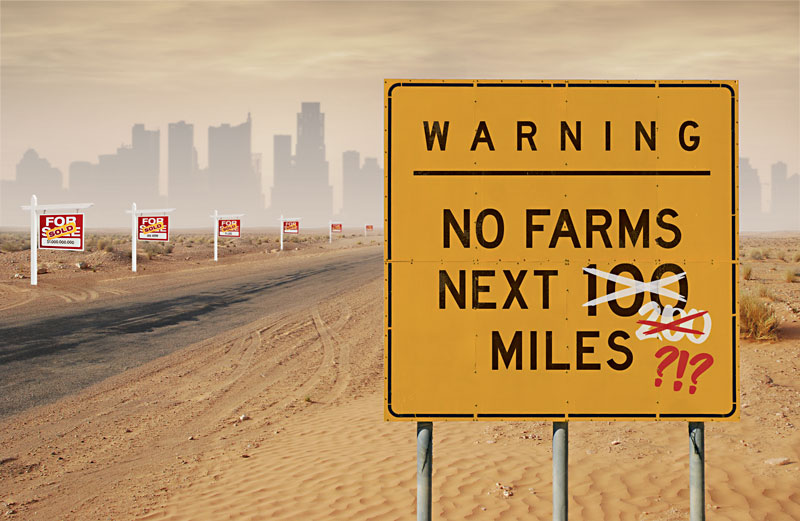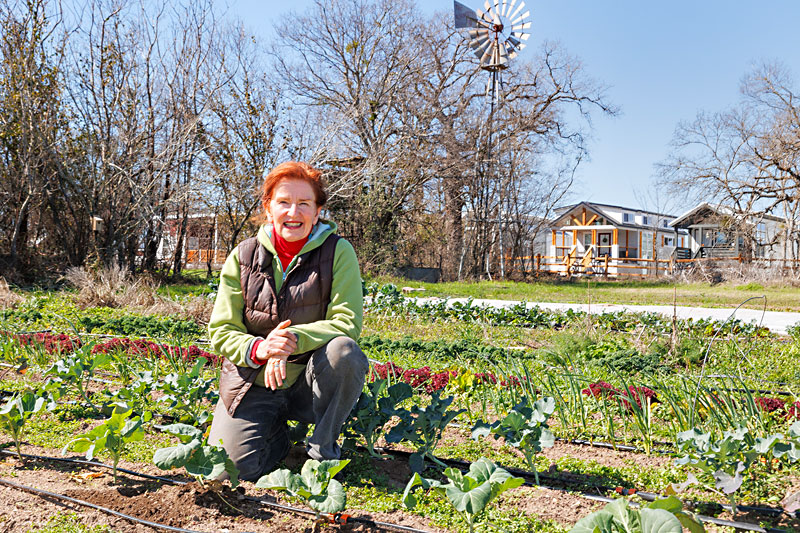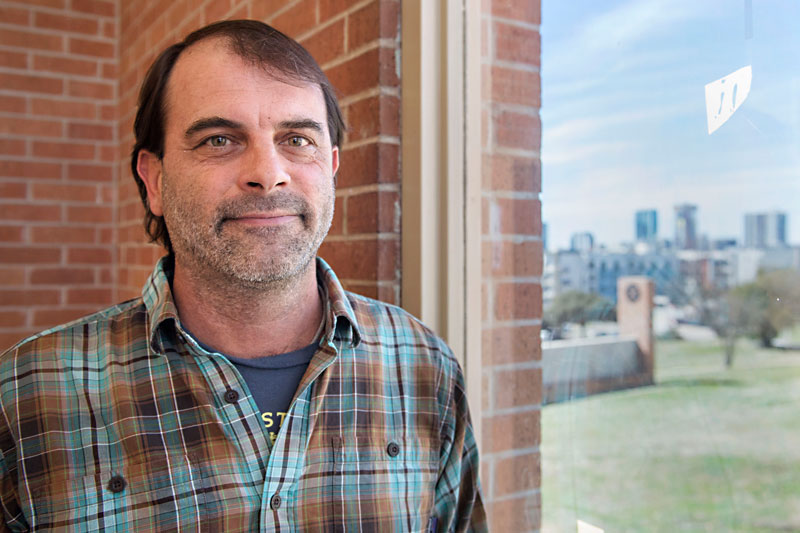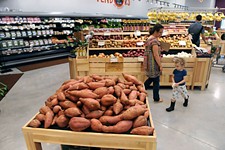As the Region Booms, Farmers Struggle to Feed Austin Locally
A lack of farmland preservation threatens a fragile food web
By Chad Swiatecki, Fri., Feb. 24, 2023
Erin Flynn and her husband, Skip Connett, are farmers, and they're being squeezed on many sides by the Central Texas boom. Their Green Gate Farms property in Northeast Austin, which they've rented for 17 years, shrunk from 10 acres to 4 – with only 1.4 acres in production – after a California developer purchased the property with plans to convert it all into housing.
The couple, and the community of supporters Green Gate has built over the years, succeeded in convincing that developer to preserve some of the land and construct a tiny home "agrihood," where residents could enjoy more than 100 varieties of fruit and vegetables grown nearby. A handful of volunteers interested in farming visits every Saturday to help pick or plant, and nearby residents come over to purchase kale, tomatoes, onions, and other organically grown produce.
Near Bastrop, where the couple owns 32 acres, the situation is more alarming. Gravel mines and Elon Musk's Boring Co. are among the commercial interests acquiring fertile farmland along the horseshoe bend in the Colorado River between FM 969 and Texas 71. Its good soils – a combination of Houston Black clay and silty loam that easily holds water – are far more productive for growing than much of the land around Austin (especially to the north and west) that's better for grazing. However, the proximity to good water from the river also makes that land attractive for aggregate mining operations.
Farmland prices have more than tripled in the area in recent years, with sales topping $40,000 per acre – a price that's far beyond growers who want to operate organically on small holdings rather than factory farming. Flynn is actively networking with local growers to combat loss of farmland. She talks passionately about the intricate web of issues she feels are being overlooked by Austinites who take their food for granted – food waste and the loss of organic material that has to be reintroduced to the soil as purchased compost or fertilizer; the increasing distance food has to travel to stores and tables in Austin; and the fragility of the local food system in natural disasters such as Winter Storm Uri or even this month's ice storm.
"The fundamental problem is a lack of farmland preservation in Austin: a lack of funding, a lack of awareness that we need to have farmland preserved because if you don't, it's all developed. People will say we can't have farmland because we need to have affordable housing. But what we're trying to show with this agrihood is that they're actually asking the wrong question," she says.
"If Austin is going to feed itself, and deal with climate change and food security, then we need to decide where our food is going to come from. Local policy does not set aside enough farmland within Austin, but if you go to other cities, they plan differently and will have a green ring around where people live so that the food production is close."
A $2.3 Billion Gap
Flynn's concerns may come as a surprise to Austinites used to the masterful logistics of retail giant H-E-B and the abundance of options at restaurants for locavore-minded customers. But less than 1% of the food consumed in Austin and Travis County is produced here, and we spend $2.3 billion a year bringing in the rest. There are only 10 food processing facilities in the five-county Austin metro area, compared to more than 100 in the Dallas-Ft. Worth Metroplex. Every day, Travis County loses 16.8 acres of farmland to development; that means every three weeks, an area equal to Zilker Park stops producing fruit, vegetables, or livestock.
The reality of fast-growing Austin is that local farms are disappearing and being pushed increasingly far away, which means longer trips on trucks to market or to production and packaging facilities elsewhere in the state. It's been on the mind of Edwin Marty, food policy manager for Austin's Office of Sustainability, who's spent much of the past year forming the team and process to conduct the city's first-ever five-year food plan. The 25-member advisory committee began meeting in late January; the final product should be presented to City Council in 2024.
The plan will cover a broad array of food-related issues, including farmland preservation, food access and security, and the resiliency of the local food system during times of crisis. Marty spent recent months presenting to city boards and commissions and fishing for members of the advisory committee, building awareness of the often alarming realities of Central Texas' fragile food system.
Part of the problem, Marty explains, is that Austin was planned and constructed as a much smaller city than it has become; while the metro area's population has grown tenfold since the 1960s, little attention has been paid to how all those people will be fed. In recent times, as the ongoing boom has created a housing crisis, the most productive farmland in the region, in the Eastern Crescent, is increasingly vulnerable to redevelopment.
Austin's ongoing boom and current rush to build more housing "has outstripped the typical things that a large municipal community would have infrastructurewise," Marty says. "We've certainly outstripped the capacity for public transit, those kinds of pieces. But the often [over]looked components are food system infrastructure. When you look at the substantial decrease in local food production over the last 10 years, and a widening gap between the food that's consumed locally and produced locally, you have to start looking at underlying causes. Obviously, land development is one of those."
He's concerned that Austin needs more commercial kitchens and food processing and packaging facilities, along with subsidies or other economic tools to help local farmers expand their land holdings or make other capital improvements to increase production. "If we had a better-developed food infrastructure, we would most likely see more small farmers being able to survive, scale up to midsize production, and really address the local market."
The plan will be informed by data from more than a dozen previous city studies and reports, most notably the Climate Equity Plan – also produced by the Office of Sustainability – that calls for the city to reach net-zero emissions in an equitable way by 2040. Karen Magid, who sits on the new advisory committee, said the challenge in synthesizing roughly a year's worth of community feedback will be deciding what outcomes will mean the plan was successful.
She said Austin and Travis County should already be addressing short-term problems with the local food supply, such as the effect of inflation on food availability for at-risk populations. "There isn't a perfect answer for what a perfect food system looks like," said Magid, who also serves as a member of the Austin-Travis County Food Policy Board. "We know some of the directions we want to go with addressing food insecurity and getting more local power into the food system. It's important to identify and have conversations about the things we should already be doing in the short and medium term while we develop a longer-term vision, without getting overwhelmed trying to put everything into one plan."
The Business of Good Food
Austin's food planning will need to fit alongside Texas' state agricultural policies, which local producers say are still rigidly tied to the "three Cs" of cattle, corn, and cotton. While there are other significant cash crops produced throughout the state, small farmers, community gardeners, and adventurous entrepreneurs feel overlooked in an agriculture economy that's dominated by centralized factory-scale production and logistics.
Flynn chuckles with frustration recounting the five-year fight to get a state agriculture exemption on the Bastrop acreage they bought 13 years ago; Connett jokes about wealthy dentists who can keep a handful of cattle on otherwise nonproducing farmland to qualify for the exemption, which can reduce their property taxes by 90% or more. Other priorities of Texas' business leaders and politicians can also easily sideline efforts to increase food production.
Nearly a decade ago, Elgin resident Sue Beckwith, who serves as executive director of the Texas Center for Local Food, started work to open the Elgin Local Food Center, a modest commercial kitchen to bring together growers and entrepreneurs. The 10,000-square-foot center, projected to cost $1.55 million in 2019, also would have featured two training kitchens for Elgin-area students and hosted rotating food trucks selling food made on the premises.
Beckwith moved ahead with plans to open the center in downtown Elgin, with the city receiving a $95,000 technical assistance grant from the U.S. Department of Agriculture and the city's economic development corporation pledging $800,000 in matching funds. That money never materialized, Beckwith says, as potential investors turned their attention and dollars away from Main Street and toward the two highways on the edge of Elgin.
Plans for the ELFC have now gone the way of the heavily promoted Elgin Agrarian Community, which was planned for 80 homes adjacent to a 3½-acre farm on the city's northern edge, beginning in 2017. That property is now a brewery and farm, owned by Circle Brewing.
Beckwith said she'd hoped the kitchen space could ease some of the difficulties faced by growers in the Eastern Crescent, who face longer trips to points of sale as rising land prices force them to move farther from markets. "We still churn out a lot of farmers. They stay in business for a couple of years and then stop farming, and there's a whole lot of reasons for that, but one of them is a lack of storage and processing facilities," Beckwith said. "[ELFC] wasn't designed to be like a cannery or a huge bottling plant, but the idea was to be a catalyst for further business development in the Eastern Crescent, to service the farmers and the growing population. Houses out there are $300,000, and the median income per family is about $52,000. People are spending half their money on housing and transportation, and that doesn't leave much for food, insurance, health coverage, clothes, and all the rest of it."
Beckwith's food center would have met some of the needs identified in the 2019 Feasibility Study for a Central Texas Food Hub, conducted by the Austin-based Sustainable Food Center. In addition to finding ample need for a facility that would centralize the sale and some processing of goods from the area's small and medium-sized farms, the study said those growers need greater access to farmland and labor and more planning support to coordinate planting and pricing levels to meet the needs of larger buyers.
That study laid out a path forward that included opening the Elgin facility, establishing aggregation nodes, improving support from federal farm programs, and, over a five-year span beginning in 2023, researching the potential for an area food industry cluster. Marty says pandemic challenges and regional food distributor Common Market's move into the Austin area sapped some of the ambition and enthusiasm behind the food hub.
But the demand still remains, he says, for large-scale coordination of local agriculture products so companies and organizations with large campuses throughout the area – including Austin ISD – can reliably buy simple items like organic, ethically produced chicken from local suppliers. "We've been talking for years about this mythical 6-ounce boneless skinless chicken breast. If we could get one that was grown in Texas, certified organic, certified animal welfare, certified fair labor, we know that there's a huge market for that product," Marty says.
"But it doesn't exist yet, so in part, what we need is a food hub to help negotiate that, and tell the potential chicken producers, 'This is the product that we're looking for, this is the way the institutions would need that product, and this is the price point. Now how do we help you get your system to a point where it can produce that product?'"
Cameron Molberg would certainly like to do his part to solve the chicken breast problem. Business has been good for the co-CEO of Greener Pastures Chicken, with the Elgin-based company expected to reach a 22,500 birds-per-week threshold by the end of the year. Demand for the certified organic meat products from Greener Pastures has been so strong that Molberg is weeks away from opening a new $13 million facility in Elgin that could process 25 birds per minute. That's large for an independent producer, but Molberg points out it's still less than one-tenth the capacity of a single line in a giant Tyson Foods plant, the nation's largest poultry producer.
To meet long-term demand for 45,000 birds per week, Molberg and his business partners will need more land. Elgin is feeling the land price pressure spilling over from Austin, so the company will have to look farther south and east, to farther-flung towns like Cameron and Dime Box – 50 or so miles from Austin – to be able to afford its next expansion.
Molberg said he's glad to have acquired the land he did to allow the company to serve the demand in the area, but he joins others in voicing frustration over the lack of attention paid to the region's food network, especially after it buckled and left many hungry during Winter Storm Uri. "It's always been concerning to know that we only have two to three days' supply of food for our community. We have a strategic oil reserve, so we can run our automobiles and other gas-guzzling infrastructure, but we can't feed ourselves," he said.
"We can't be reliant on these isolated institutions and these mega-factories where, if one of them goes out, next thing you know half the state of Texas doesn't have beef for eight months or a year or even longer. I've often thought that we need to diversify and have smaller production facilities and more localized distribution channels."
Going Where the Need Is?
The onset of the COVID-19 pandemic in spring 2020, and Winter Storm Uri in February 2021, led some local food providers to change their entire operational models to keep meals moving toward those in need. That included Good Work Austin, a nonprofit originally formed to provide education and business resources to early-stage restaurateurs, which pivoted with COVID to use its members' idle kitchens to prepare meals for school districts, nonprofits, shelters, community centers, and other gathering places.
Three years later, restaurants continue to take on city contracts for meals needed throughout the community. Kevin Lawler, GWA's executive director, quickly and loudly offers his support of an Austin-area food hub to improve access to local products and help fill the gap in preparing badly needed meals.
"If the city or other partners had a central hub, we would certainly want to be a partner and want to support that," he said, noting that the growing distances traveled by suppliers have created regular problems with procuring ingredients. "We would really like to see the farmers, ranchers, the people growing food supported. Obviously so many of our restaurants are good supporters of local farms and there's a lot of benefit to having a strong network of local producers supporting not just our restaurant community, but the community at large."
If that hub or improved coordination among local producers ever materializes, Michelle Akindiya said it's unlikely to change many of the entrenched inequities that make local farming inaccessible to middle- and low-income residents. Worse, the economics of ethically sourced local products – grown on increasingly expensive land using fairly paid laborers and lacking economies of scale enjoyed by factory farms – mean that even if local food production greatly increased, much of that food would be too expensive for poorer residents who typically subsist on subsidized, mass-produced, imported food.
As education director for Farmshare Austin, a big part of Akindiya's job involves making those harsh realities clear for newcomers interested in taking up farming and participating in the more robust fair food system Food Share wants to create. The imbalanced economics of local food production mean Akindiya's students typically can't get food to the people they often most want to help, once they go through the time and expense of getting a new farm up and running.
"You almost have to be privileged to be able to farm," Akindiya says. People "getting into farming now, doing small-scale farming, [who] want to pay people a living wage and want to pay themselves a living wage, are forced to sell into a really high-end market. They're selling to restaurants and at specialty farmers' markets at a high price, because that's what it costs to grow and to be able to make a living. There is a market for that, because Austin is a foodie town and there is a population here that can afford to pay those premium prices for really good produce. But how do we make it more accessible to more of our neighbors?"
Akindiya sees potential in programs such as the Working Farms Fund, which purchases at-risk farmland and leases it to beginning farmers for up to five years, with an option to buy. That fund, which operates in Chicago and Atlanta, has reportedly examined making Austin one of its next regions. She hopes the reality of food access will come into clearer focus if energy and commodity prices continue to increase.
"People aren't as shell-shocked as they were, when you went to the grocery store during COVID or during the winter storm [and saw] a lot of empty spaces instead of there being food all over the place," Akindiya says. "But if we were to look at the landscape with the mindset of, 'How do we feed our population?' we would be planning much differently for the development that's coming in. It would be really interesting to understand where the prime farmland is for different kinds of farming and say, 'Here's the best place to grow food, so let's not put condos here. Let's not put a golf course here. Let's actually put a farmer here.'"
Got something to say on the subject? Send a letter to the editor.













